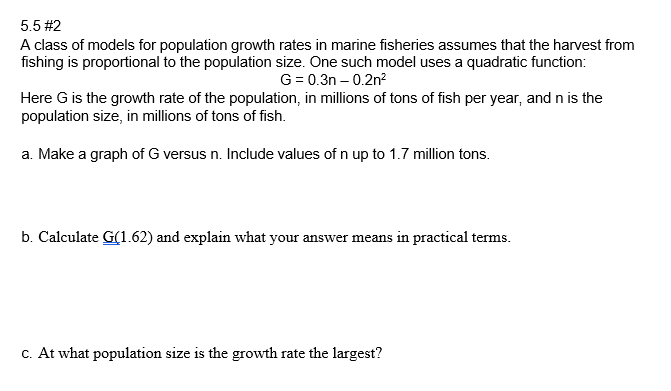A class of models for population growth rates in marine fisheries assumes that the harvest from fishing is proportional to the population size. One such model uses a quadratic function: G = 0.3n – 0.2n? Here G is the growth rate of the population, in millions of tons of fish per year, and n is the population size, in millions of tons of fish. a. Make a graph of G versus n. Include values of n up to 1.7 million tons. b. Calculate G(1.62) and explain what your answer means in practical terms. c. At what population size is the growth rate the largest?
A class of models for population growth rates in marine fisheries assumes that the harvest from fishing is proportional to the population size. One such model uses a quadratic function: G = 0.3n – 0.2n? Here G is the growth rate of the population, in millions of tons of fish per year, and n is the population size, in millions of tons of fish. a. Make a graph of G versus n. Include values of n up to 1.7 million tons. b. Calculate G(1.62) and explain what your answer means in practical terms. c. At what population size is the growth rate the largest?
Algebra & Trigonometry with Analytic Geometry
13th Edition
ISBN:9781133382119
Author:Swokowski
Publisher:Swokowski
Chapter4: Polynomial And Rational Functions
Section4.6: Variation
Problem 2E
Related questions
Question
Please answer all parts and write on the website so I can understand or try to make your handwriting readable as much as you can if you prefer to write on paper.
Also, please include the labels on each axis, units on each axis, scale on each axis, make it a good graph. Thank you

Transcribed Image Text:5.5 #2
A class of models for population growth rates in marine fisheries assumes that the harvest from
fishing is proportional to the population size. One such model uses a quadratic function:
G = 0.3n – 0.2n²
Here G is the growth rate of the population, in millions of tons of fish per year, and n is the
population size, in millions of tons of fish.
a. Make a graph of G versus n. Include values of n up to 1.7 million tons.
b. Calculate G(1.62) and explain what your answer means in practical terms.
C. At what population size is the growth rate the largest?
Expert Solution
This question has been solved!
Explore an expertly crafted, step-by-step solution for a thorough understanding of key concepts.
This is a popular solution!
Trending now
This is a popular solution!
Step by step
Solved in 4 steps with 5 images

Knowledge Booster
Learn more about
Need a deep-dive on the concept behind this application? Look no further. Learn more about this topic, algebra and related others by exploring similar questions and additional content below.Recommended textbooks for you

Algebra & Trigonometry with Analytic Geometry
Algebra
ISBN:
9781133382119
Author:
Swokowski
Publisher:
Cengage

Glencoe Algebra 1, Student Edition, 9780079039897…
Algebra
ISBN:
9780079039897
Author:
Carter
Publisher:
McGraw Hill

College Algebra
Algebra
ISBN:
9781305115545
Author:
James Stewart, Lothar Redlin, Saleem Watson
Publisher:
Cengage Learning

Algebra & Trigonometry with Analytic Geometry
Algebra
ISBN:
9781133382119
Author:
Swokowski
Publisher:
Cengage

Glencoe Algebra 1, Student Edition, 9780079039897…
Algebra
ISBN:
9780079039897
Author:
Carter
Publisher:
McGraw Hill

College Algebra
Algebra
ISBN:
9781305115545
Author:
James Stewart, Lothar Redlin, Saleem Watson
Publisher:
Cengage Learning